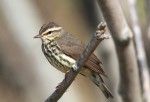
It was only fitting that Stanislaus Audubon President Sal Salerno and Board member Ralph Baker were along when Harold Reeve added another bird to the Stanislaus County list.
Reeve has been counting birds in Stanislaus County for over thirty years. He’s kept meticulous records of species, high and low counts, and rare occurrences. Periodically, the Stanislaus Audubon Society publishes an updated list of Reeve’s additions to the county bird list, including sightings documented by other birders.
Most Audubon Board members have themselves added to knowledge of local birds, so the addition of species, their numbers and status (common or uncommon, etc.) has always been a group effort, including records from birders just visiting the county.
When Reeve began compiling what would become the official county list, the total number of species observed and documented to occur in Stanislaus County was around two-hundred sixty. Today, the list includes well over three-hundred species.
Late last month, Reeve, Salerno, and Baker were censusing a restricted area near Patterson when they came upon a quiet pool near the San Joaquin River. “That’s where the Northern Waterthrush is going to be,” said Salerno. The remark elicited a chuckle from Baker and Reeve.
Most experienced birders are good at “reading habitat,” a skill which enables them to predict what kinds of birds will be found in given places. The little pool where the birders stood was indeed an ideal spot for a Northern Waterthrush, but all three birders knew that a Northern Waterthrush had never been seen in Stanislaus County and is very rare in the entire state. They normally breed in Canada and winter in Mexico and South America.
As Salerno and Baker walked on in search of wintering birds and late migrants, Reeve paused and listened intently at background chips, chirps, and whistles. An extremely patient birder with a good ear, Reeve will often remain in one spot long past the time other birders have lost interest, listening for odd chip notes or songs.
What held his interest now was a distant but loud “chip” unlike anything he’d ever heard in Stanislaus County. Reeve tried whispering the bird in closer, using a technique called “pishing,” which involves making sibilant “psh” sounds. As the chips got louder and louder, Reeve realized the bird was responding to his calls.
Suddenly, the bird shot out of the tangle across the pond and landed on an oak branch just above Reeve’s head. After signaling Baker, who was nearby, Reeve took mental notes and produced the following description:
Having seen the under parts very well I was fairly certain of the bird’s identification, but it was not until it (finally) cocked its head and looked down at me that I was completely certain that it was a Northern Waterthrush. The face was mostly medium brown, with the auricular set off by a whitish border around the bottom and rear. A narrow, blackish-brown eyeline extended through the eye and provided sharp contrast to the uniformly narrow white eye stripe just above the dark eye. At this time Ralph and I both agreed that the bird seemed to definitely be a Northern Waterthrush.
When the bird flew to a neighboring branch, Reeve was able to shout to Salerno to come running. Salerno arrived in time for a good look, and agreed it was indeed a Northern Waterthrush, the very species he had jokingly predicted would be found beside the quiet poolside in Stanislaus County.
The Northern Waterthrush now joins well over three-hundred birds on the official Stanislaus County bird list. It also joins Reeve’s own list of birds seen in Stanislaus County, and puts him within three or four species of the magic number of three-hundred for the County.
California birders consider three-hundred species seen in the entire Central Valley a benchmark of excellence. Harold Reeve is very close to achieving that number in Stanislaus County alone. Meanwhile, Ralph Baker and Sal Salerno are happy to join the chase.

I saw a Northern Waterthrush for the first time last May, 2013, in Delaware’s Bombay Hook National Wildlife Refuge. They are common visitors there in the spring, on their way north from wintering grounds. It was a striking bird, with its prominant throat and eye stripes, wonderful to have one spotted here in Stanislaus County!